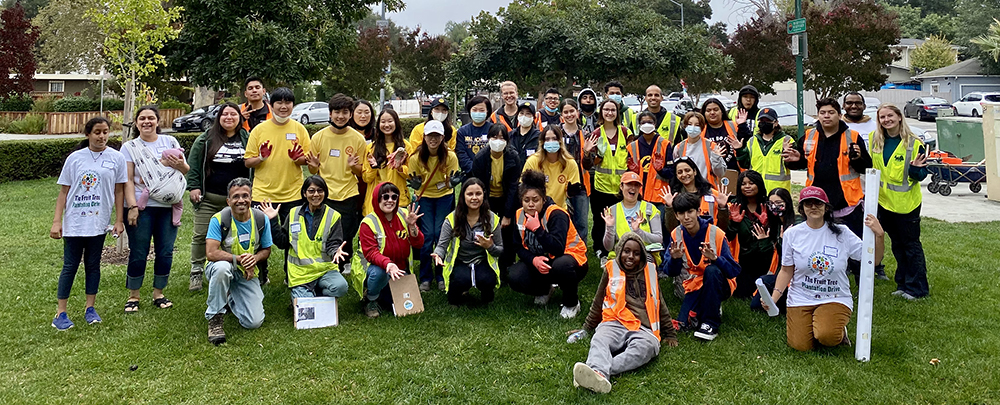- About Us
- Our Work
- Tree Info
- Get Involved
- Blog
- Volunteer
- Support Us
By Canopy Team on December 13, 2022

Trees planted by Canopy along the East Palo Alto soundwall.

A satellite photo tells the East Palo Alto tree canopy story powerfully, as pictures often do. The image is overlaid with jurisdiction lines for the cities of Palo Alto, East Palo Alto, and Menlo Park, with the tree canopy in each city highlighted in neon green. Much of Palo Alto and Menlo Park are covered in green, illustrating those cities’ 38 percent and 27 percent average tree canopy rates, respectively. By contrast, East Palo Alto looks mostly gray, with tree canopy covering just 13.5 percent of its land.
The satellite image is part of “From Gray to Green: An Urban Forest Master Plan for East Palo Alto.” The East Palo Alto City Council adopted the plan and updated tree ordinances in April 2022 with the goal of expanding the city’s tree canopy.
“It’s a dream come true,” says Catherine Martineau, Canopy executive director, of the master plan’s creation and adoption. “As the smallest city in Silicon Valley, with a largely BIPOC population, East Palo Alto has historically faced socioeconomic challenges rooted in systemic racism and disinvestment. Yet its city council adopted one of the most innovative urban forest master plans I’ve seen. This positions the city to expand an urban forest that is substantially underdeveloped compared to those in surrounding wealthier communities.”
Canopy championed the city’s tree master plan from the start, identifying a funding opportunity and advising on community engagement and advocacy—along with planting close to 3,000 trees in the city since 2007. Canopy joined a diverse set of partners including the nonprofit San Francisco Estuary Institute (SFEI), which led the master plan project and brought a historical ecology lens to the city’s urban forestry challenges and opportunities; East Palo Alto community members, City Council, and city staff, who guided and reviewed the plan’s during its development; and HortScience Bartlett Consulting, which advised on the municipal tree ordinances.
A grant from the California Department of Forestry and Fire Protection’s Urban and Community Forestry (Cal Fire UCF) Program funded the project. Grants from Cal Fire UCF are funded by the California Climate Investment Fund (built through carbon offset fees), which stipulates that 75 percent of its funding be invested in low-resource communities.
Among the master plan’s strengths and innovations, Catherine says, is a wealth of recent data and state-of-the-art urban ecology science informing its recommendations. “The plan also carefully incorporates the history and specificity of East Palo Alto and the results of a thorough community outreach process,” she says. “The plan doesn’t shy away from recognizing and naming the causes of the inequity in tree canopy cover.” The plan sets two goals: growing the city’s canopy cover to 30 percent by 2122 and building community engagement to provide stewardship of the urban forest.
The unique nature of the plan began with the hiring of SFEI as the project lead. The ecosystem research group, which published Re-Oaking Silicon Valley: Building Vibrant Cities with Nature in 2017, focuses on biodiversity and ecological resilience of urban ecosystems. More typically, a large tree company or forestry experts would be hired for a project like this, Catherine says.
“Urban forest master plans are a way to support biodiversity and promote resiliency,” says Erica Spotswood, former program science director at SFEI. “It’s hard to incentivize biodiversity in its own right, so the way in is through people, by making the connection between urban forests and human health.” The challenge—especially in small, resource-limited cities like East Palo Alto—is that “as a society, we don’t treat trees like other pieces of infrastructure. It’s a value decision we make socially. If a pipe breaks, cities have people and a budget line to fix it. Trees give us so many benefits, but most cities have no more than one person to help with trees.”
Catherine was part of a small group steering the plan’s progress through a number of hurdles, including the COVID-19 pandemic, uprisings over racial injustice, and more. In fall 2019, she met in the backyard of Laura Martinez, a Canopy board member and former East Palo Alto mayor, along with Carlos Romero, vice mayor and former mayor of East Palo Alto; Michelle Daher, City of East Palo Alto Environment Programs Management Analyst, and Uriel Hernandez, an urban forester and former East Palo Alto planning commissioner. They envisioned the master plan team, with Michelle suggesting SFEI as the lead. Then the pandemic hit, forcing Michelle to devote most of her time to COVID testing. The group almost lost its grant funding due to slow progress, but Cal Fire offered a year’s extension because of the pandemic. “Considering the world-changing events of 2020 and 2021, this is an amazing accomplishment,” Catherine says.
“This project was uniquely interdisciplinary, working with a great group of partners,” Erica says. Although resources in the city are restrained, “the city’s staff members were very supportive. Canopy brought lots of on-the-ground community experience, and what we heard from the community is that they are very excited about trees.”
“It is remarkable and visionary that East Palo Alto, a relatively young and small city, is adopting its own urban forest master plan,” Catherine says. “Many larger and well-resourced cities don’t have one, although urban trees are an essential and indispensable nature-based solution to climate change and other public health challenges.”
